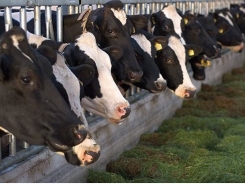How to properly assess dairy cow trace mineral status

No single simple analysis can accurately profile minerals in ruminants
Photo by Andrea Gantz
Mineral profiling is often used to assess deficiencies and/or toxicities — as well to evaluate different dietary trace mineral sources and to investigate under performance. While blood tests are probably the most common method used to assess mineral status in ruminants, they may not necessarily be the most appropriate and subject to limitations.
Tests can measure minerals directly, as well as functional problems and/or proteins unique to the mineral. Hence, there is often more than one test for the same mineral with varying specificities. With the development of techniques, such as inductively-coupled plasma/mass spectroscopy (ICP/MS), samples can be analyzed rapidly, accurately and relatively less expensive compared with older methods.
Whatever the sample tissue used, there are principle considerations when interpreting the results, including age of the animal; prior and current health/disease status; production stage and dietary intake of the mineral in question, as well as the intake of antagonistic compounds.
Assessment can also be on an individual or group basis.
Sample tissues
Sampling of tissues can be carried out ante- or post-mortem, depending on the situation and what you are trying to achieve. Both liver and urine can be used ante- and post-mortem, whereas milk is reserved for live animals only. Additionally, post-mortem, ocular fluid and bone tissue can be sampled.
There are obviously some tissues that are more easily sampled, and others that would not be viable, post-mortem. In live animals, whole blood and its respective fractions (serum and plasma) is most commonly used. It is relatively non-invasive and can give indications of deficiencies and/or toxicities. Despite this, blood is not a particularly accurate reflection of status for many important minerals as it is influenced by disease and dietary intake.
Blood sample accuracy varies
Most trace elements are not static within the body. They will be located in pools: a storage pool, transport pool and functional pool. That said, not all minerals have a recognizable storage pool. Depletion generally occurs in the order of storage — transport followed by functional — thus resulting in clinical deficiencies.
Blood is a transport pool for many minerals and low values here may not be an accurate predictor or reflection of a clinical issue, serum copper (Cu) being one example. Whole blood vs. serum selenium (Se) can also be used as an example. The latter is a measure of the transport pool and is correlated with dietary intake while the former can represent both transport and functional pool and is less sensitive to changes in dietary intake.
Additionally, turnover of red blood cells (RBC) means that response to supplementation is generally slower in whole blood compared with that in serum and this should be considered in the timing of sampling.
A further limitation is the homeostatic control of some mineral elements resulting in little change in blood values. The magnitude of effect of different influencing factors on blood mineral levels varies with mineral. For example, Se level is greatly affected by diet but less so by animal factors while the reverse is true for Cu.
Liver samples most accurate
Liver tissue samples are often considered the most accurate regarding mineral status but are obviously more invasive to obtain. Despite this, liver concentrations are not always associated with disease presence. However, changes in concentration in the transport pool (usually blood and/or serum) are often buffered via release of mineral from the liver storage pool, suggesting liver status may be a better indicator of dietary adequacy.
Analysis of the activity of mineral-specific enzymes (e.g. glutathione peroxidase), i.e. the functional pool, possibly is more appropriate for determining clinical deficiency disease.
Other testing samples
Urine is popular for attempting to assess mineral status, especially during the transition period. However, results are significantly affected by hydrations status so correction factors, such as mineral to creatinine ratios should be employed to remove this effect.
Milk mineral content is affected by parity and stage of lactation and levels of some minerals are regulated.
Hair sampling is becomingly increasingly popular in other species. Mineral concentration in hair is affected by growth cycles and the piece sampled reflects the mineral concentration at the time that hair was made, rather than real time. There is also an element of ‘contamination’ due to exposure to sebaceous, apocrine and eccrine secretions. Relation of hair values to other indicators of deficiency is poor and few reference values exist.
Individual mineral analysis
Low levels of serum calcium and magnesium are related to a metabolic deficiency, whereas bone concentration gives a better indicator of a long-term, true deficiency. For dairy cows, it’s usually the metabolic issues that are of interest so the use of serum values is advocated. Phosphorous requires bone to give an accurate idea of status and other parameters should be used as a guide. Again, serum is useful for both sodium and potassium, although urine can also be used to evaluate sodium.
For the main trace elements, liver is deemed the most reflective of status but is not always a feasible option. Cu can be detected in serum, in addition to whole blood levels of superoxide dismutase, although the latter responds more slowly to deficiency.
Plasma ceruloplasmin accounts for the vast majority of Cu in blood but, again, levels respond slowly until marked depletion of stores has occurred. Combinations of whole blood and serum Se, as well as whole blood glutathione peroxidase can give a reasonable indication of status, although liver is better. However, blood parameters, especially serum Se, are significantly influenced by intake, including source of Se. Serum zinc is reduced in a deficiency but even ‘normal’ values cannot rule out a deficiency.
The levels of many trace minerals are affected by disease as inflammation can increase circulating levels of protein-bound minerals, such as ceruloplasmin.
Accuracy a challenge
There is no one simply analysis for the assessment of mineral status of livestock. While techniques, such as ICP/MS have significantly improved analytical efficiency, the parameters tested may still not give an accurate impression of mineral status.
Various tissues can be tested for levels of mineral element and mineral-specific proteins. Liver appears the tissue most reflective of status, but blood and blood fractions are most commonly used. However, a number of factors, including age and dietary mineral intake affect results.
It’s crucial to have an understanding of these factors, as well as how minerals are stored and utilized within the body, to accurately interpret any mineral analysis.
References available on request.
About Author: Dr. Helen Warren, owner of HW Consulting, achieved her Ph.D. from Bristol University. After working in academia, she worked for a global animal health company. She is currently chair of the British Society of Animal Science Industry Association, a registered animal scientist and certified Cow Signals trainer.
Có thể bạn quan tâm
Phần mềm

Phối trộn thức ăn chăn nuôi

Pha dung dịch thủy canh

Định mức cho tôm ăn

Phối trộn phân bón NPK

Xác định tỷ lệ tôm sống

Chuyển đổi đơn vị phân bón

Xác định công suất sục khí

Chuyển đổi đơn vị tôm

Tính diện tích nhà kính

Tính thể tích ao hồ



 Improving dairy cow performance with fiber-degrading enzymes
Improving dairy cow performance with fiber-degrading enzymes  Fiber-degrading enzymes increase dairy cow milk production
Fiber-degrading enzymes increase dairy cow milk production